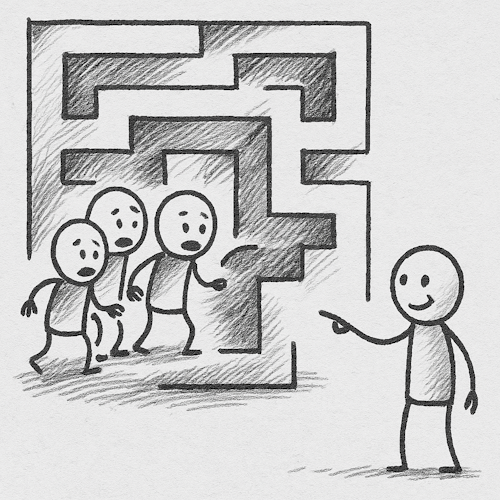The Team In The Maze
Illustrates Navigating Complexity, Teamwork, Discovery
One of the most difficult challenges Agile teams face is navigating complexity without losing alignment or momentum. It's easy to feel stuck. The Team in the Maze parable explores how vision, communication, and systems awareness allow teams to move forward when the path is not obvious.
Agile coaches often encounter teams that are doing the work but feel directionless. They are trying to be Agile, but are unsure if they are improving. This parable helps teams reflect on their behaviors and relationships in times of confusion.

A group of people wakes up in a maze. No one knows how they got there, and the walls are too high to see over.
At first, everyone starts moving in different directions, calling out when they hit a wall. Progress is slow. Arguments begin. Some grow tired and stop.
One person finds a ladder, climbs up, and sees the whole layout. She realizes the group is going in circles.
She comes back down. "I see a path, but I can't carry you there. I can guide you."
Some listen. Others keep guessing on their own.
The ones who align with her direction start moving together. They talk often. They test different turns. They find landmarks. Eventually, they make it out and help others do the same.
Those who escaped begin building signs and maps for the next group.
Lessons Learned
Clear Vision Enables Movement
The ladder represents systems thinking. When one person sees the whole, they can provide direction. Agile coaches, Product Owners, and experienced team members help uncover context others might miss.
Collaboration Is the Only Way Out
No one can escape the maze alone. Even those with insight cannot force others to follow. Shared understanding and trust are essential. The maze symbolizes complex, adaptive systems, everyone is needed to sense and respond.
Autonomy Requires Alignment
The people who refused help were autonomous, but they were not aligned. Autonomy without alignment leads to wasted effort. Agile teams must balance empowerment with shared purpose.
Progress Is Iterative
The group did not escape all at once. They made small advances, tested paths, and built confidence. This mirrors Agile's inspect-and-adapt rhythm. Frequent feedback leads to better decisions.
Learning Compounds When Shared
The team that got out first didn't stop. They left signs for others. This captures the spirit of knowledge sharing and Retrospectives. Agile growth multiplies when teams teach what they've learned.
Coaching Tips
- Visualize the Maze: Ask teams, “Where are we in the maze? What walls are we hitting?” Use this to identify systemic blockers and gaps in visibility.
- Normalize Climbing the Ladder: Encourage someone to step back and see the whole picture. This could be a coach, but it can also be a team member running a value stream mapping session or identifying constraints.
- Model Alignment with Autonomy: Let the team reflect on times when they felt lost versus aligned. What changed? What helped?
- Create Your Own Signs: Invite teams to document and share discoveries, pitfalls, and working agreements. This turns learning into leverage.
Agile teams are often stuck not because they lack skill or motivation, but because they can't see the system clearly. The Team in the Maze parable offers a story that resonates with teams navigating complexity. It reminds us that clarity, collaboration, and shared direction can illuminate the path forward.
Teams don't need someone to carry them out. They need someone to show them where they are, and trust them to move.


